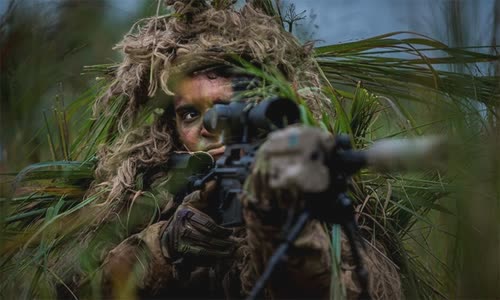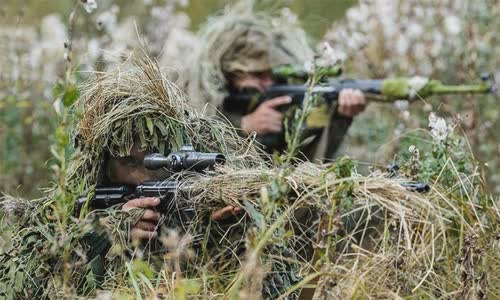Despite dominating sniper field in the Middle East and North Africa for many years, American gunners seem to be surpassing Russian soldiers.
A 2016 report by the US Army said Russian snipers were "much more skilled than what US snipers have dealt with in the last 15 years".

A sniper sniper of the 100 infantry battalion in camouflage attends the photo session at McGuire-Dix-Lakehurst, New Jersey, USA, July 2017 Photo: US Army
Sniper equipment is the first area the US military faces an increasing challenge from Russia, said Task & Purpose editor Jared Keller.
The U.S. infantry is armed with precision weapons, including the M40 sniper rifle, the semi-automatic sniper system (SASS) M110, the Enhanced Sniper Rifle (ESR) M2010, and the M107 sniper rifle (Barrett M82A1).
However, the Russian military recently staffed the sniper rifles SVCh Chukavin and Orsis T-5000 Tochnost, with ranges of 1.4 km and 1.6 km respectively, in order to replace the Dragunov model from the Soviet Union chapter.
"The Russians have caught up with the United States on essential issues like technology and ammunition," said Christian Wade, a former sniper sniper of the US Marine 2nd Division.
The Pentagon is seeking to cope with the technology.
The Army, the Marines, and the US Special Operations Command (SOCOM) have all planned the payroll of a sniper rifle called MRAD of Barrett.
MRAD uses 7.62 × 51 mm NATO bullets, .300 Norma Magnum and .338 Norma Magnum with ranges of over 1.4 km, the company said.
However, the military's military procurement system slows down the process of equipping new sniper rifles instead of the old model.
"The Pentagon is not adapting fast enough to threats from Russia and China," Wade said.
Besides the advancements in weapons technology, Russian snipers also have a theoretical advantage.
The US Army's 2016 report acknowledged that the methods used to deal with enemy snipers that had been successfully used by the US in the fight against terrorism in Afghanistan and Iraq are now "ineffective with the gunner's versatility.

Russian sniper participated in the Tsentr-2015 exercise (Center-2015) in Chelyabinsk province, September 2015 Photo: BQP Nga
While Russia constantly trains snipers, the US Army and Marines do not value the sniper force, placing sniping in the sub-skill group instead of the group that needs to be honed because of its high value.
"If you don't turn someone into a full-time sniper, you won't have enough professional people to deal with Russian snipers, even if the technology is equivalent," Wade said.
Better weapons and materials for snipers are not enough for the US military to catch up with Russia in this field, former Army Brigadier General Robert Scales said.
Scales contends that the advantage of the regular American sniper gunner is "severely limited" because the "proprietary function" of this position consumes the combat power of small units.
Outdated stereotypes about sniper forces are a major problem for the US military, Scales said.
The former officer said that the US military needs to expand its skills, knowledge and technology so that instead of only one gunner shooting targets above 1,200 m in each company, all soldiers in the unit can
"Combining this overwhelming damage with the ability to destroy targets at a distance of 1,000 meters or more with a mortar or anti-tank guided missile, we completely reverse the firepower advantage that the enemy may have."
Editor Jared Keller believes that Russian snipers will continue to cause difficulties for their opponents.
However, the U.S. Army and Marines' snipers may prove to be formidable gunners on the battlefield in the future, by speeding up their weapons upgrades and changing their training process.
"Until then, it will be possible to tell if one sniper has an advantage over another," said former sniper gunner Wade.



 Catherine Alshalabi
Catherine Alshalabi







